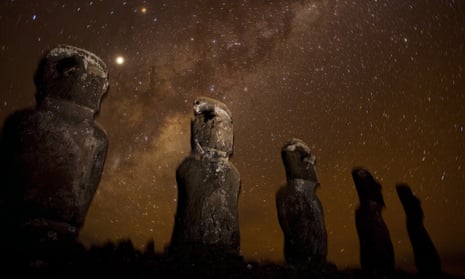We hear a lot about how we are running out of resources, but for many people it is hard to visualise. Sometimes I’m asked: “Could it really happen?” The simple answer is yes, it could. And a lot sooner than we might think if change isn’t initiated soon. In fact, we have examples of where it has already happened.
The stone-carved faces of Easter Island are shrouded in mystery and intrigue. But behind them hides a past – one where an island, once bountiful and rich in resources, was consumed until all the natural capital was exhausted.
When European explorers came across the island in 1722, they arrived to find no trees remaining over 10-feet tall. For the islanders, the consequences were fatal: they left themselves no timber to fuel their fires, create fishing boats or build shelter from. Their collapse was inevitable. Some have since wondered what they were thinking when they cut the last remaining tree down.
It’s not an easy comparison to make to the British Isles, or indeed the rest of the world. This was a remote island isolated by shores that lay thousands of miles off the mainland, leaving little allowance for plan B. Things are different now – we have modern technology that brings the world closer together, with capabilities to transport, import and export goods should there be a geographic shortfall in resources. But the principles remain the same.
We know from lessons of the past that those who have stripped all available natural resources have suffered, such as those on Easter Island. But, looking at the present day, we also know that if the European lifestyle was adopted globally, we would need three planets worth of resources to support it. We can’t just go on forever, taking everything we can.
There’s no doubt that we need a plan. And there is a solution – the circular economy. The circular economy keeps resources in circulation for longer. It means that rather than taking or extracting natural resources from the source, the materials that have already been taken can be recovered and reused in a variety of ways, protecting these virgin resources from over-exploitation. To achieve this requires alternative business models, such as reuse, remanufacture, rental schemes, design for repairability and recycling. This approach protects the environment, increases business resilience from material price volatility and creates jobs while doing so – three tick boxes for any political agenda.
It’s not just about preserving the natural environment. The World Economic Forum estimates that $1tn could potentially be saved by businesses that adopt circular business models, which also benefits consumers. One example of a circular model in action is the resource-efficient peer-to-peer “sharing economy”, where businesses such as AirBnB and Zipcar have facilitated platforms that allow people to share belongings or property. This model is expected to reach £9bn by 2025, according to PwC.
And now the latest study by Wrap and the Green Alliance has for the first time pinpointed exactly what jobs could be created from a more circular uptake, and the results are encouraging.
Government projections suggest that a decline of 67,000 lower-skilled jobs (pdf) in the labour market will be expected within the next decade. But this report suggests that continued uptake of the circular economy could create more than 200,000 jobs.
If circular economy activities received extensive expansion, expectations are even more promising. If given a significant push, it could be possible to see more than 500,000 jobs created – this would be the equivalent of providing jobs to every single resident in a city the size of Edinburgh, with job vacancies still plentiful. Unemployment could also be reduced by 102,000, which in turn could offset up to a third of the expected decline in skilled employment over the next decade.
What’s key is that there are strong opportunities in places where unemployment is high, particularly in the north-east and West Midlands. With spare employment capacity, it’s likely recruitment would be successful and regional disparity tackled.
By increasing existing activities such as the waste and recycling sector, and transferring manufacturing skills into remanufacturing skills, a range of jobs could be created, especially in operational and elementary labour roles. For example, 40% of unwanted electrical goods end up in landfill and less than 10% are re-used, despite much of it still being in good working order, or at least repairable. If we were to increase circular activity, people could be employed to collect unwanted goods, skilled technicians could then be employed to repair, refurbish or reassemble them, and sales and customer service personnel could be employed to trade the finished products once fit for use.
We already know the consequences of not safeguarding our natural resources. Let those deserted civilisations that perished because their natural capital ran out be a reminder to us all.
This new report adds to the growing case for the uptake of the circular economy. There’s a positive scenario that’s being laid out on the table if the opportunity is seized. It demonstrates that we can live within our means and prosper economically from doing so.
At the report’s launch, Walter Stahel, originator of the circular economy concept, laid out the following scenario: if a businessman says to you he wants to make money from opening a manufacturing plant, then why not suggest that he can make five times as much from opening a remanufacturing plant? As he said: “We have to sell the circular economy to different people using their own language”.
The circular economy hub is funded by Philips. All content is editorially independent except for pieces labelled ‘brought to you by’. Find out more here.
Join the community of sustainability professionals and experts. Become a GSB member to get more stories like this direct to your inbox.

Comments (…)
Sign in or create your Guardian account to join the discussion